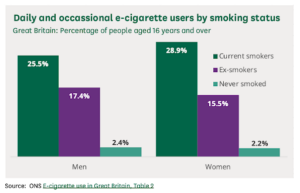I gclaochlú suntasach le déanaí ón ngnáth-insint dhiúltach sna meáin faoi vapáil agus laghdú díobhála sa Ghearmáin, d’fhoilsigh Der Spiegel scéal a sheasann amach. Thug an t-alt cuntas mionsonraithe ar thuras tuairisceora chun scor de chaitheamh tobac trí vapáil, ag cur peirspictíocht chruinn agus intuigthe i láthair ar na rioscaí coibhneasta a bhaineann le vapáil i gcomparáid le caitheamh tobac. Tá an píosa seo, atá ar fáil... anseo, is seoid annamh í i dtírdhreach a bhíonn ceoach go minic le hamhras agus mífhaisnéis.
Mar sin féin, ní raibh an freagra ar an alt seo, go háirithe ó phearsana polaitiúla mór le rá, chomh dearfach céanna. Renate Künast, polaiteoir ceannródaíoch ó Pháirtí Glas na Gearmáine agus iar-Aire um Chosaint Tomhaltóirí, cáineadh an t-alt, ag tabhairt le fios gur píosa bolscaireachta a bhí ann seachas scéal fíor faoi scor tobac. Léiríonn a freagairt ceist níos leithne i bpolaitíocht sláinte na Gearmáine - leisce chun aitheantas a thabhairt do na buntáistí féideartha a bhaineann le galú mar uirlis chun scor tobac a chaitheamh.
Tá an seasamh seo ag dul i gcoinne an fhianaise eolaíoch atá ag fás agus ag tacú le galú mar mhodh éifeachtach scoir tobac. Mar shampla, an tseachtain seo caite, an Cochrane Dheimhnigh an t-athbhreithniú le cinnteacht ard go gcabhraíonn galúcháin nicitín le níos mó daoine scor de chaitheamh tobac ná Teiripí Athsholáthair Nicitín traidisiúnta (NRTanna). In ainneoin seo, tá amhras agus séanadh glan fós i dtírdhreach polaitiúil na Gearmáine.
Ina theannta sin, tá Oifig Náisiúnta Staidrimh na Ríochta Aontaithe tar éis teoiric an gheata a bhréagnú go héifeachtach, rud a léiríonn gur caiteoirí reatha nó iar-chaiteoirí tobac beagnach gach duine a úsáideann tobac. Cuireann na sonraí seo dúshlán an scéil gur bealach chuig caitheamh tobac é an tobac a úsáid, ach ina ionad sin leagann siad béim ar a ról maidir le cabhrú le daoine a chaitheann tobac éirí as.

Tá leisce ar pholaitíocht sláinte na Gearmáine glacadh le galú mar uirlis laghdaithe díobhála ag éirí níos fadhbaí, go háirithe i gcomparáid leis an dul chun cinn atá déanta i dtíortha eile. Tá an tSualainn, mar shampla, ar tí a bheith saor ó thobac, den chuid is mó a bhuíochas dá cur chuige forásach maidir le laghdú díobhála. I gcodarsnacht leis sin, leanann an Ghearmáin de bheith ag streachailt le breis agus 100,000 bás a bhaineann le caitheamh tobac gach bliain.
Tá sé in am athrú mór a dhéanamh ar pholaitíocht sláinte na Gearmáine. Trí bhreathnú ar mhúnlaí rathúla cosúil le samhlacha na Sualainne, is féidir leis an nGearmáin cur chuige níos éifeachtaí agus níos trua a ghlacadh maidir le scor den chaitheamh tobac. D’fhéadfadh glacadh le straitéisí laghdaithe díobhála, lena n-áirítear galú, saolta gan áireamh a shábháil agus ualach sláinte poiblí an chaitheamh tobac a laghdú go suntasach.
Tá níos mó i gceist le scéal Der Spiegel ná rath duine aonair; is glao chun gnímh é do lucht déanta beartas chun athmhachnamh a dhéanamh ar a seasamh maidir le galú agus laghdú díobhála. De réir mar a mhéadaíonn an fhianaise agus de réir mar a dhéanann náisiúin eile dul chun cinn maidir le rátaí caitheamh tobac a laghdú, ní mór don Ghearmáin gan moill a chur ar bheartais a ghlacadh a thugann tús áite don tsláinte phoiblí agus a ghlacann le straitéisí laghdaithe díobhála cruthaithe.






Freagra amháin